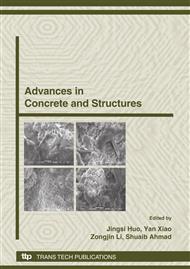p.379
p.385
p.391
p.395
p.403
p.409
p.415
p.421
p.427
Performance of Polypropylene Fiber and Rubber Powder Improved High Strength Concrete
Abstract:
Based on high strength concrete (HSC), the improved HSC concrete was produced by adding different contents of fine grain rubber particles and polypropylene fibers. The grain size of the rubber particle is 420 m and the rubber content is 1%, 2%, and 3% of the mass of cementitious material respectively. The volume fraction of polypropylene fiber is 0.1%.The performance of HSC, rubber particle improved high strength concrete (RHSC), polypropylene fiber improved high strength concrete (PHSC) and polypropylene fiber hybrid rubber particle improved high strength concrete (PRHSC) before and after high temperature are studied. The investigation methods used are the external surface inspection, weight loss and residual strength testing. The experimental results show that rubber particles can improve the workability of HSC and PHSC under normal temperature. Polypropylene fiber can significantly improve the spalling failure resistance property of HSC and RHSC.
Info:
Periodical:
Pages:
403-408
Citation:
Online since:
October 2008
Authors:
Price:
Сopyright:
© 2009 Trans Tech Publications Ltd. All Rights Reserved
Share:
Citation:


